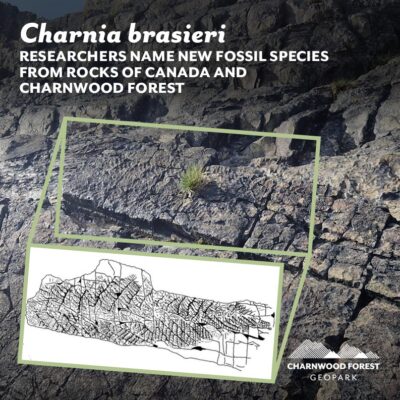Researchers from Canada’s Memorial University of Newfoundland have named a new fossil from the rocks of Charnwood Forest. The exciting new addition to the Geopark’s fossil family comes after years of careful study by the team at sites like Charnwood Forest’s Bradgate Park, and also fossil localities in Eastern Newfoundland.
Named Charnia brasieri, the new fossil is closely related the first fossil ever discovered in Charnwood Forest: Charnia masoni. Indeed, for many years, the example of C. brasieri from Bradgate Park was considered to be a very large specimen of Charnia masoni. However, the team led by Prof Duncan McIlroy have re-examined the material from Charnwood Forest and Canada, and they noticed that the branching pattern of some Charnia specimens was different, and didn’t fit with anything previously described. A new species therefore needed to be created.
Charnia brasieri would have lived on the ancient seafloor around 560 million years ago, and like Charnia masoni is one of the oldest animal fossils yet discovered. So rare are these fossils, that the exact location of sites within Charnwood Forest are not published to help keep them safe. Visitors can still delve deeper into the region’s fossil story with a visit to one of our fossil-themed geosites, including Discovering Charnia and Bradgate Park – Bradgatia.
In naming the fossil Charnia brasieri, the team chose to honour the late Prof Martin Brasier (1947-2014). Martin was Professor of Palaeobiology at the University of Oxford, and spent many years studying Precambrian fossil localities around the world – including many of the fossil sites mentioned in this new study, like Charnwood Forest Geopark, Discovery UNESCO Global Geopark, and the Mistaken Point UNESCO World Heritage Site.
Prof McIlroy, who was Martin’s first doctoral student, said the following upon publication of the new fossil in the journal Precambrian Research: “Martin was a huge influence on me as a scientist but also as a person. Even now whenever I feel like I’ve discovered something innovative or exciting I wish I could call him up and talk it through with him. He was there for me at my very lowest and heartily celebrated all my achievements. I’ve wanted to name something after Martin ever since he died in a car accident in 2014, shortly after he retired, but I wanted it to be something special. I feel like he would have enjoyed this.”
He added: “Incidentally, Charnia brasieri was the first Ediacaran fossil I ever saw in the field (on a perfect late Autumn day, with perfect late afternoon lighting conditions), with Martin in Charnwood Forest Geopark!” The Ediacaran is the name for the geological period of time when these strange and fascinating creatures would have been living on the seafloor.
On hearing the news of the new fossil species, the Geopark’s Geoheritage Officer, Jack Matthews commented “Martin played a key role in work to better understand and conserve the ancient fossils of Charnwood Forest, so it is incredibly appropriate that his memory should live on through the naming of this new species of Charnia. Martin was not just an incredibly intelligent and successful scientist, he was also a kind and generous gentleman who’s legacy also lives on through the ‘academic family’ of geologists he trained. We are excited to look at ways the Geopark can celebrate the story of Charnia brasieri and share it with the public.”
In 2024, Bradgate Park was recognised as a National Nature Reserve due to the importance of the Ediacaran fossils found there. Thanks to this new research, we can add one more species to the list of fabulous fossils found amongst the crags of Bradgate. Visitors to Bradgate Park are reminded that the fossil localities are now accessible to the public. Discover more about these fossils by visiting the Deer Barn Visitor Centre or the Bradgate Park – Bradgatia geosite.

The above photo is an example of Charnia brasieri from Charnwood Forest, alongside a line drawing of the specimen drawn by the late Prof Martin Brasier around 2005.
